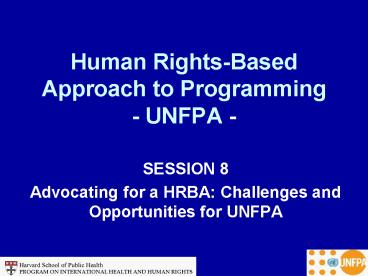Human Rights-Based Approach to Programming - UNFPA - - PowerPoint PPT Presentation
Title:
Human Rights-Based Approach to Programming - UNFPA -
Description:
Title: Health and human rights: Bridging theory and practice Abstract #144579 Author: Jessie Evans Last modified by: Luz Angela Melo Created Date – PowerPoint PPT presentation
Number of Views:59
Avg rating:3.0/5.0
Title: Human Rights-Based Approach to Programming - UNFPA -
1
Human Rights-Based Approach to Programming-
UNFPA -
- SESSION 8
- Advocating for a HRBA Challenges and
Opportunities for UNFPA
2
Session Overview
- UNFPAs advocacy role
- Advocacy strategies
- Obstacles and challenges
- Strategies for challenging contexts
- Importance of cultural sensitivity
- Conclusion
3
UN Country Team Role
- information, education
- participation
- organization
- monitoring
- access to remedies
- (administrative, judicial)
- laws
- policies
- services
- data, monitoring
- remedies
fulfil duties
CSO
Capacity development
claim rights
duty-bearers
rights-holders
Information, participation, organization,
monitoring
advocacy
technical assistance
laws and policies
service delivery
UN-CT support
Source Action 2 CLP
4
UNFPAs Advocacy Role
- What are the different ways in which UNFPA
engages in advocacy? - with governments, other duty-bearers?
- with individuals, civil society, other
rights-holders? - within the UNCT?
- at the international level?
- others?
5
Strategies (1)
- Know where the government stands on various
issues - Know how advocacy and programme implementation
might be most effectively carried out - For example
- legislative reform may be required and
legislative capacities may need to be
strengthened - policy reforms may be needed to combat
discrimination and ensure consistency between
macroeconomic and social policies and more
equitable public policies
6
Strategies (2)
- In order to devise and deliver effective
advocacy, engage in environmental scanning - Allows understanding of factors that create or
constrain an enabling environment - Analysis should consider overall legal, political
and economic environment, and be sensitive to the
critical role of local culture - Remember An enabling environment entails
building a human rights culture
7
Obstacles and Challenges (1)
- Challenging contexts include places where there
is - Lack of political will to deal with issues seen
as especially sensitive or controversial - Overt resistance to the concepts and methods of
human rights (including for ostensible cultural,
religious or other reasons) - Open political resistance to human rights
8
Obstacles and Challenges (2)
- Challenging contexts include places where there
is - Lack of political commitment and/or weak capacity
to develop and implement a HRBA - Resistance to acknowledging certain populations,
and therefore resistance to ensuring the human
rights of those populations - Cultural or religiously sanctioned subordination
of women, and where negative attitudes towards
women and stereotypes are deeply entrenched
9
Obstacles and Challenges (3)
- Challenging contexts include places where there
is - Government that operates in a highly centralized
manner, with limited public accountability - Violent conflict, widespread poverty or extremely
weak capacity, where basic survival or
institution building is seen as a priority - Generally weak governance or other significant
structural and political barriers
10
Strategies for Advocating in Challenging Contexts
- Work with culture
- Emphasize that a HRBA is synonymous with national
ownership - Show that human rights are not a foreign concept
- Demonstrate that you know the value of a HRBA
- Emphasize capacity development
- Do the best you can in each specific situation
- Be patient, and work progressively towards change
11
Advancing ICPD Agenda and a HRBA Without Saying
Human Rights (1)
- Talk about the benefits of a HRBA, e.g.
- national ownership
- sustainable programmes
- capacity development
- engenders the trust of the citizenry
- improves long-term development outcomes
- uncovers root causes of development challenges
- use data to show disparities
- the focus on process
- 3AQs
12
Advancing ICPD Agenda and a HRBA Without Saying
Human Rights(2)
- Refer to nationally entrenched rights in
constitutions and domestic legal standards - Reassure governments that you can help them meet
their international commitments - Share UNFPAs own efforts to ensure
accountability, participation, etc. - Change terminology
- reproductive health or healthy families may
be less controversial than family planning or
reproductive rights - Build development around the strengths and
interests of the people involved
13
Importance of Cultural Sensitivity
- Cultural or religious traditions and practices
can be in opposition to UNFPAs efforts - Working to change behaviours and attitudes is
extremely time-consuming with limited immediate
obvious impact - Incremental changes are possible and may be more
enduring in the long run. This is the reason why
UNFPA promotes a culturally sensitive HRBA - Essential to design and implement programmes that
work from within a culture
14
Conclusion
- Integrating human rights into development
assistance is not simply a technical matter
resolved by adequate training or better tools and
procedures - In addition to knowledge of what a HRBA means in
practice, it requires negotiation with
governments, consensus-building, and adapting to
potentially difficult and unfriendly contexts































